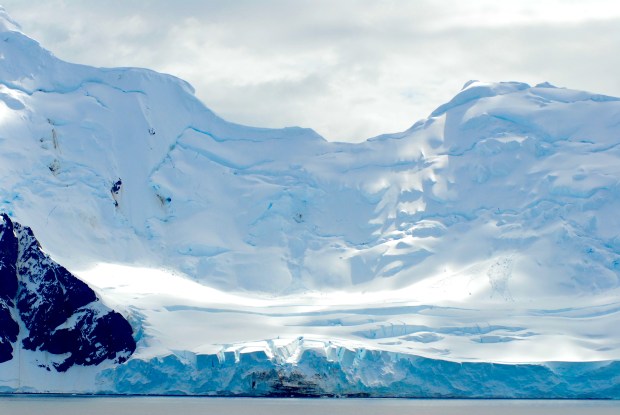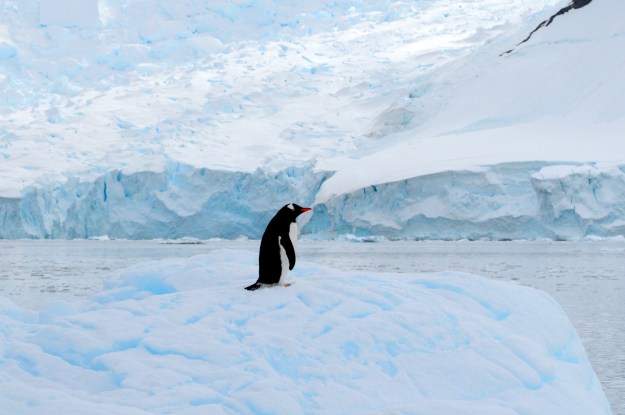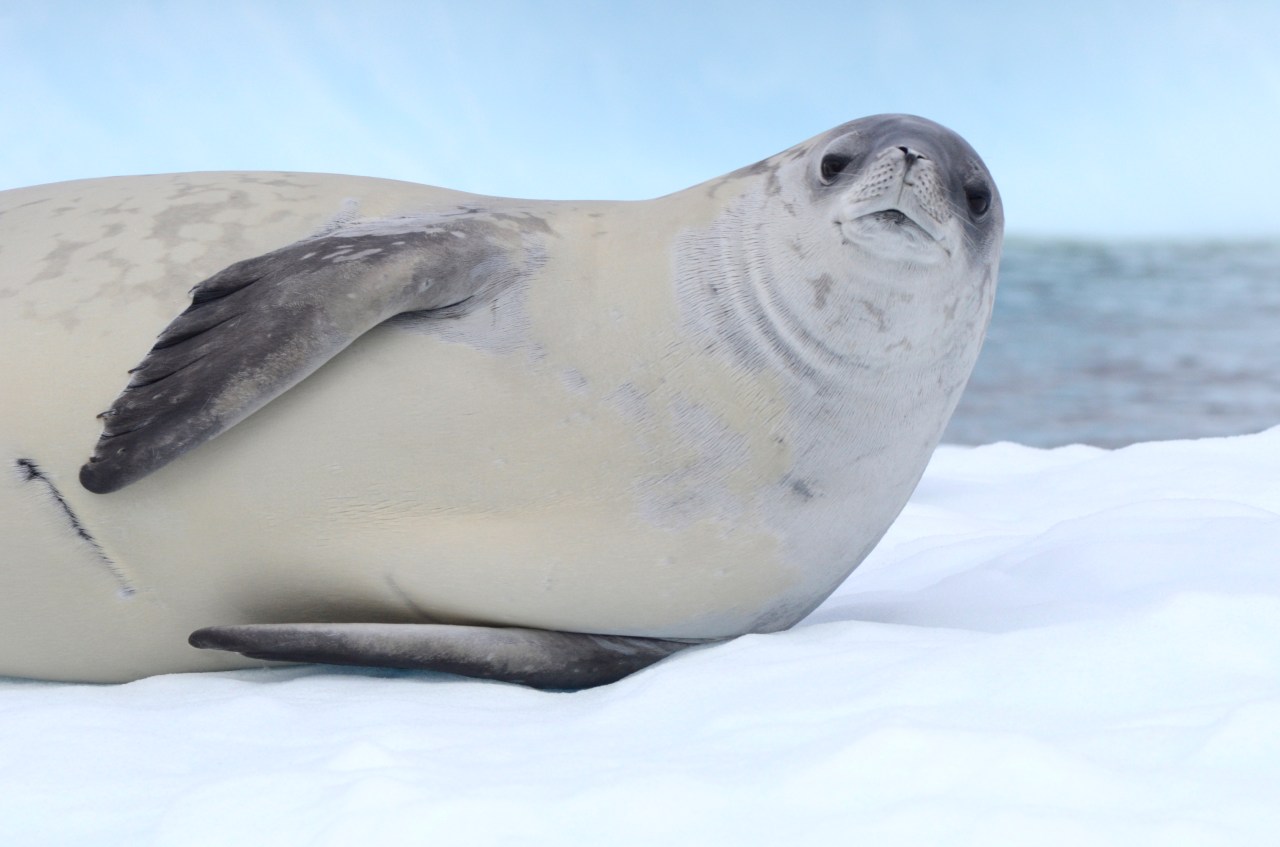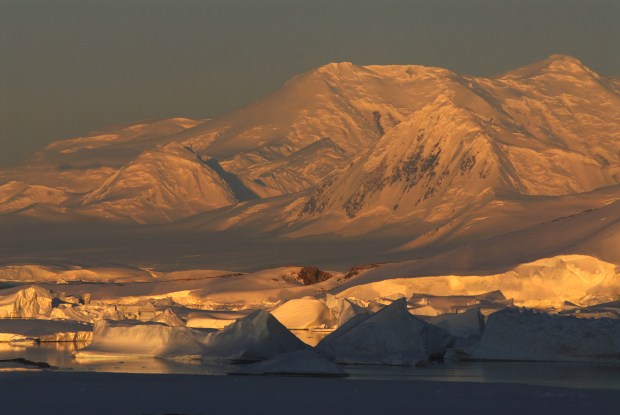I’m on the very tip of the Antarctic Peninsula, and this notoriously rough and windy section—the Antarctic Sound—is unusually calm. The sea is so still and windless here that the exhalations of humpback whales linger like smoke.
The Antarctic Peninsula is the frozen continent’s exception. If the continent were a fist, it would be the index finger pointing north to within about 620 miles of South America. The peninsula is nicknamed Antarctica’s banana belt because of its relatively mild climate and “abundance” of greenery—moss, lichen, and two flowering plants. But even this northernmost tip is anything but temperate.
We’re here to see tabular icebergs. Formed when they break off from ice shelves, these behemoths are what garner so much of the media attention about the effects of climate change. Ice shelves are floating glaciers. They occur when ice sheets extend from the shore and splay out. Most of the Antarctic coastline is made of ice shelves, expanses that can be ½ mile thick with 330-foot cliffs. The largest is the Ross; at almost 200,000 square miles, it is nearly the size of Spain. Of more recent fame is the dwindling Larsen Ice Shelf halfway down the Antarctic Peninsula.

The Larsen is divided into the Larsen A, B, and C shelves. In January 1995 Larsen A collapsed. In 2002, from the end of January to March, the Larsen B disintegrated, leaving scientists dumbstruck. It had lasted for 10,000 years only to crumble to bits in a little over a month. Then in November 2016, the Larsen C showed a worrying sign: an enormous fissure, more than 62 miles long and 295 feet wide. When it breaks off, the missing area will be greater than the size of Delaware.
Scientists are beginning to piece together why the collapses are happening so rapidly. Since 1940 the decadal increase in air temperature on the peninsula has been 32.9 degrees Fahrenheit, coincident with an increase in carbon-dioxide emissions. In addition, scientists believe that atmospheric changes are causing warm-water masses to reach underneath the ice shelves, eroding them from below.
The icebergs that break off from these ice shelves are formidable. The one threatening to leave Larsen C could well be the greatest in planetary history, easily visible from space.
This tectonic event will not have any direct effect on sea level since the tabular berg will form from a shelf that is already floating. But the ice shelf left behind may begin to break up once exposed to the sea. Glaciers, sometimes called “rivers of ice,” are dynamic: Some move just millimeters a year; others move meters. An ice shelf acts like a dam, holding in place the glacier behind it. With the Larsen A, B, and C ice shelves gone, the glacier could slide from its position on rock to floating on the water.
And there is another kind of ice being threatened in Antarctica: Sea ice, formed from the freezing of seawater at 28.76 degrees Fahrenheit, is decreasing in area and thickness due to climate change.


In polar environments, where sea life has had to evolve with ice, it’s crucial to the function and productivity of Antarctic life. One of the continent’s most critical life forms is the tiny Antarctic krill. While diminutive in size, it is one of the most abundant animals in the world by mass. In Antarctica, nearly everything eats krill. Even if one species doesn’t eat it, their prey does. It’s a keystone species.
When fall arrives, sea ice begins to expand outward from the continent. By September Antarctica has doubled in size. Under this white carpet is a pasture of sorts. Algae grow on the underside of the sea ice, where krill larvae, juveniles, and adults graze. Their ability to feed over the winter determines their population the following summer. Baleen whales and penguins eat krill. Crabeater seals are so dependent on them that they’ve evolved interlocking teeth that strain the tiny fish from the seawater. The decrease in sea ice is threatening the population. West of the Antarctic Peninsula, one of their most critical habitats, there has been a 70 percent decrease in population since the 1970s.
That decrease is driven by more than climate change, however. There is a creature draining the krill from the oceans: humans. Enormous krill trawlers ply Antarctica’s water, sucking up copious quantities of the tiny creature for aquaculture, cattle and pet feed, and omega-rich krill oil for the health industry. Antarctica’s ecosystem is being burnt at both ends.
In addition to krill, Antarctica has a plethora of harvestable fish species, such as the highly sought-after toothfish. With a swath of ocean too large to monitor, unregulated fishing could harm Antarctica’s little-understood marine environment. While there are regulated and managed fisheries, as well as controls under the Antarctic Treaty System, piracy is an ongoing threat.
Increased atmospheric carbon dioxide also causes ocean acidification. Carbon dioxide more readily dissolves in cold water, forming carbonic acid. Unfortunately for the frigid Southern Ocean surrounding Antarctica, a more acidic ocean will eventually make it impossible for marine organisms to form their shells from calcium carbonate. Many of these shelled organisms are plankton, essential to the Southern Ocean’s food chain. Krill, squid, and fish eat plankton; these species are in turn fed on by penguins, seals, and whales. Animals like plankton also help control climate change by using carbon dioxide to make their shells. When they die, the trapped carbon dioxide is transported to the seabed. Ocean acidification could prevent this carbon sink.

As sea temperatures rise, Antarctica will face a new spiny threat with three legs and two claws: the king crab. Currently, king crabs live in waters north of the continent. When Antarctica’s shelf waters warm, this and other predators could invade, eliminating species before we even discover them. Marching slowly along the seafloor just off the continental shelf, they could endanger Antarctica’s benthos—the seabed life that has existed unchanged for eons—with their ravenous appetite.
Of course, the most enigmatic member of the frozen continent is the penguin. Although flightless and black and white, it might be considered Antarctica’s canary for climate change. Food quality and availability and nesting conditions will primarily determine the penguin’s survival. If food sources such as krill diminish, penguins will show the symptoms with fewer chicks or disappearing colonies. Meanwhile, changing ice and snow dynamics will affect nesting areas—the stable ice platforms that emperors need and the dry, stony ground the Adélies need.
The Antarctic Treaty of 1959 created a political anomaly: a continent twice the size of Australia, set aside for peace and science. With no native human population, Antarctica pertains to no one but the creatures that inhabit it. The fact that no country is wholly responsible for Antarctica is exactly what makes it so vulnerable and its future so uncertain.
But we’ve done some things right.

Thanks to an international agreement and worldwide efforts to control man-made chlorofluorocarbons (CFCs), recent measurements have shown that not only is the ozone hole over Antarctica stabilizing, but it might even be making a recovery.
Between 2011 and 2015 on the enormous island of South Georgia, the largest rat-eradication program in history saw the elimination of the rodents that arrived with the first sealers in the 18th century. Rats eat the eggs and chicks of ground-nesting birds, to devastating effect the world over. Since there are no trees in South Georgia, every bird is vulnerable. But, following the final phase of the rat-eradication program, the island’s birds are showing signs of recovery too, including Antarctica’s only endemic songbird, the South Georgia Pipit.
On this northern tip of Antarctica, I try to count the whale blows but soon give up. More than a century ago some whale populations were slaughtered—90 percent of the population of some species—but today the humpbacks surrounding our vessel show nature’s resilience. And the Antarctic fur seals that were butchered for their pelts until only a couple hundred remained now number more than 4 million on South Georgia alone.
Antarctica has the power to transform people. With every new group that arrives, from China or Africa, I’ve watched travelers, struck with awe at the power and rare beauty of nature, come to terms with their own insignificance. Future ambassadors for Antarctica are created with every ship. Tourism is a double-edged sword, though. As Antarctica becomes more popular, more ships will visit, increasing traffic, affecting penguin and seal colonies, and putting more pressure on an already vulnerable ecosystem. Fortunately, this impact is minimized by the highly conscientious International Association of Antarctic Tour Operators (IAATO), a model of self-regulated tourism.
The Antarctic Treaty is, finally, a wonderful example of how opposing countries can come together to create an agreement utterly unique in world history: designating a continent for peace and science and a model of international cooperation.

Antarctica, where whaling and sealing saw the near extermination of entire species, seems like the trial ground for human follies, feats, and opportunities to work together. Its remoteness and sheer inhabitability require countries, even of opposing politics, to collaborate and support one another’s scientific efforts.
The Larsen Ice Shelf will collapse. There is no denying it or stopping it. But we can ameliorate future change and potentially even reverse it.
Antarctic weather is ever changing, and the placid scene here in the Antarctic Sound has been replaced by mercury peaks and white foam, gray sky, and frigid 80 kph winds. The space between my eyebrows numbs, and I’m reminded of drinking a milkshake too fast. Looming in the distance are three tabular icebergs. Their size becomes apparent only when the Endeavor navigates between them, their white, plasticlike faces towering above us. Waves crash against them as if they were unmoving islands. It is hard to believe that these icebergs, which are dwarfing our ship, are relatively small, but they are. The biggest tabulars and the Larsen C—the behemoth yet to come—stretch farther than you can see.